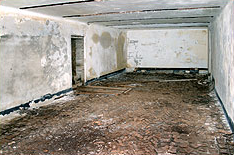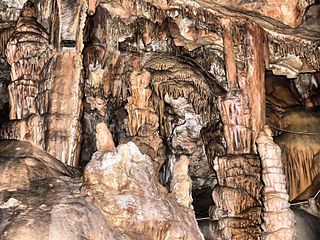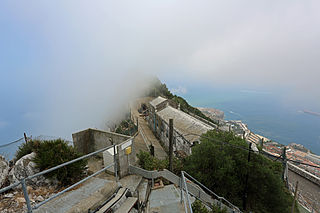
Operation Bodyguard was the code name for a World War II deception strategy employed by the Allied states before the 1944 invasion of northwest Europe. Bodyguard set out an overall stratagem for misleading the Oberkommando der Wehrmacht as to the time and place of the invasion. Planning for Bodyguard was started in 1943 by the London Controlling Section, a department of the war cabinet. They produced a draft strategy, referred to as Plan Jael, which was presented to leaders at the Tehran Conference in late November and, despite scepticism due to the failure of earlier deception strategy, approved on 6 December 1943.

Gorham's Cave is a sea-level cave in the British overseas territory of Gibraltar. Though not a sea cave, it is often mistaken for one. Considered to be one of the last known habitations of the Neanderthals in Europe, the cave gives its name to the Gorham's Cave complex, which is a combination of four distinct caves of such importance that they are combined into a UNESCO World Heritage Site, the only one in Gibraltar. The three other caves are Vanguard Cave, Hyaena Cave, and Bennett's Cave.

The military history of Gibraltar during World War II exemplifies Gibraltar's position as a British fortress since the early 18th century and as a vital factor in British military strategy, both as a foothold on the continent of Europe, and as a bastion of British sea power. During World War II, Gibraltar served a vital role in both the Atlantic Theatre and the Mediterranean Theatre, controlling virtually all naval traffic into and out of the Mediterranean Sea from the Atlantic Ocean.

St. Michael's Cave or Old St. Michael's Cave is the name given to a network of limestone caves located within the Upper Rock Nature Reserve in the British Overseas Territory of Gibraltar, at a height of over 300 metres (980 ft) above sea level. According to Alonso Hernández del Portillo, the first historian of Gibraltar, its name is derived from a similar grotto in Monte Gargano near the Sanctuary of Monte Sant'Angelo in Apulia, Italy, where the archangel Michael is said to have appeared.

Lord Airey's Battery is an artillery battery in the British Overseas Territory of Gibraltar. It is located near the southern end of the Upper Rock Nature Reserve, just north of O'Hara's Battery. It was named after the Governor of Gibraltar, General Sir Richard Airey. Construction of the battery was completed in 1891. The first gun mounted on the battery was a 6-inch breech loading gun, which was replaced with a 9.2-inch Mark X BL gun by 1900. The gun at the battery was last fired in the 1970s. In 1997, it was discovered that Lord Airey's Shelter, adjacent to Lord Airey's Battery, was the site chosen for a covert World War II operation that entailed construction of a cave complex in the Rock of Gibraltar, to serve as an observation post. The battery is listed with the Gibraltar Heritage Trust.

Operation Tracer was a secret Second World War military operation in Gibraltar, a British Overseas Territory and military base. The impetus for the plan was the 1940 scheme by Germany to capture Gibraltar, code-named Operation Felix. Operation Tracer was the brainchild of Rear Admiral John Henry Godfrey, the Director of the Naval Intelligence Division of the Admiralty.
The Gibraltar Caving Group is an organisation based in the British Overseas Territory of Gibraltar. It forms the Caves and Cliffs Section of the Gibraltar Ornithological and Natural History Society. The group of skilled cavers and climbers has multiple roles, engaging in cave exploration and research, avian rescue, and rare plant discovery. It performs surveys and clears areas with limited access. However, it is perhaps most well known for the discovery that four of its members made in December 1996. While exploring tunnels in the southern portion of the Rock of Gibraltar, they found the entrance to Operation Tracer, also known colloquially as Stay Behind Cave. Rumours of a covert World War II observation post had circulated in Gibraltar for decades. The Gibraltar Caving Group continued its exploration and evaluation of the facility under the auspices of the Gibraltar Museum.

Brigadier Sir Richard Gambier-Parry, was a British military officer who served in both the army and the air force during World War I. He remained in military service post-war, but then entered into civilian life for more than a decade. In 1938, he was recruited by the head of the Secret Intelligence Service. Gambier-Parry led the Communications Section of the SIS during World War II, and assembled a clandestine wireless network that connected the United Kingdom with SIS agents in many countries, as well as helping to create the SIS resistance network in Britain. During the war, he was also recruited by the Director of British Naval Intelligence to serve as the radio consultant for Operation Tracer in Gibraltar. Post-war, he ran a network of secret listening stations.

Surgeon Lieutenant-Commander Bruce Cooper was a native of Castle Eden, England. He obtained his medical degree from Durham University. Early in his career, he tended to coalminers and joined the Royal Naval Volunteer Reserve. The physician served with distinction in the early period of the Second World War and was mentioned in despatches. In 1941, he was recruited for a highly classified mission, Operation Tracer. In the event that Gibraltar was taken by the Axis powers, he was to be sealed into a secret chamber in the Rock of Gibraltar with five other men for about a year and report the movements of enemy vessels. Over a period of two years, the secret complex was completed and the team assembled and trained. However, the mission was never activated. Cooper returned to England and served in both civilian and military capacities. The location of the secret chamber remained a mystery for decades, but was finally discovered in 1997. However, many questions remained, including the identity of the team members. Upon Cooper's return to Gibraltar in 2008, he confirmed that the cave in question was that which had been destined for himself and his five colleagues. Dr Cooper was the last surviving team member of Operation Tracer in Gibraltar.

Lord Airey's Shelter is a subterranean military shelter in the British Overseas Territory of Gibraltar. It is located near the southern end of the Upper Rock Nature Reserve, adjacent to Lord Airey's Battery. It was named after the Governor of Gibraltar, General Sir Richard Airey. The tunnel system for the shelter was chosen as the site for the highly classified, Second World War military operation known as Operation Tracer.

Martin's Cave is a cave in the British Overseas Territory of Gibraltar. It opens on the eastern cliffs of the Rock of Gibraltar, below its summit at O'Hara's Battery. It is an ancient sea cave, though it is now located over 700 feet (210 m) above the shore of the Mediterranean Sea. It is only accessible because Martin's Path was constructed.
Beefsteak Cave is a cave in the British Overseas Territory of Gibraltar. It is located in the south of the Rock, between Europa Point and Windmill Hill.
The Genista Caves are a series of caves located under Windmill Hill in the British Overseas Territory of Gibraltar. Fossils of various mammals and human remains were discovered here in the mid-1860s. The name of the caves is a play on words based on Captain Frederick Brome's name, who discovered them.

New St. Michael's Cave, also known as Lower St. Michael's Cave, is a cave system in the British Overseas Territory of Gibraltar. Unlike its namesake, St. Michael's Cave (proper), which has been known for over 2,000 years, this cave was discovered as recently as World War II.
Boathoist Cave, also known as Bulman's Cave, is a huge sea cave on the south eastern flank of the British Overseas Territory of Gibraltar.
Ragged Staff Cave is a cave bordering the harbour in the British Overseas Territory of Gibraltar. The cave was converted into Ragged Staff Magazine in 1901.

Star Chamber Cave is a limestone cave in the British Overseas Territory of Gibraltar. In the 1780s the cave became the centre of tunnels known as the Lower Galleries of the Northern Defences. In 1941 this cave was still in military use as the King's Regiment Battalion Headquarters

Spy Glass Battery or Spyglass Battery was originally a high angle artillery battery in the British Overseas Territory of Gibraltar. The battery is mounted high on the rock to give extra range and protection. The battery was still in use during the Second World War as a listening post and site for a Bofors Gun.

The Great North Road is a large road tunnel in the British Overseas Territory of Gibraltar. It was constructed by the British military during World War II inside the Rock of Gibraltar and remains property of the Ministry of Defence to this day. The road allowed lorries to travel from the north to the south of Gibraltar entirely within the Rock. The tunnel still contains the remains of World War II buildings such as Nissen huts, kitchens, offices as well as a generating station and period anti-submarine nets.

The tunnels of Gibraltar were constructed over the course of nearly 200 years, principally by the British Army. Within a land area of only 2.6 square miles (6.7 km2), Gibraltar has around 34 miles (55 km) of tunnels, nearly twice the length of its entire road network. The first tunnels, excavated in the late 18th century, served as communication passages between artillery positions and housed guns within embrasures cut into the North Face of the Rock. More tunnels were constructed in the 19th century to allow easier access to remote areas of Gibraltar and accommodate stores and reservoirs to deliver the water supply of Gibraltar.















